New 2010 Introductions
New introductions primarily from our own wild seed collections that will become available during the course of the new season. Here divided into 3 sections :
Bearing elongated slender helmets on angled stems that will twine if given a host, but also happy to form a clump of plate-like basal leaves with protruding flowering spikes.
 |
Aconitum loczyanum BSWJ11529
A. loczyanum BSWJ11529 was the obvious identity of a Japanese species we found growing in quite different conditions, from an open exposed Õnogahara Plateau, Shikoku Island Japan at 1100m in the autumn of 2006. An upright species to about a metre with dark green mottled deeply divided palmate foliage and terminal panicles of elongated slender purple helmets.
|
 |
Anemone sumatrana BSWJ11265
No prizes for guessing the home of Anemone sumatrana BSWJ11265, although we were not expecting such a temperate plant even though we were on the slopes of their highest volcano.
|
It inhabited dank forest floors where the mottled foliage formed small colonies. With the widely opening white long stemmed flowers held above, in umbels which migrate to the forest floor once flowering has ceased, rooting as they do so.
 |
Thalictrum rubescens BSWJ10006
Thalictrum rubescens BSWJ10006 is only a small species forming more scattered colonies all be it in a far more hostile environment mixed with dwarf bamboo in a sheltered gully high up on Hohuanshan eastern Taiwan.
|
T. tuberiferum BSWJ10999 was also from a challenging altitude in Japan, forming clumps of large three-lobed leaflets which had 60 cm tall stems of fluffy white flowers earlier.
 |
Paeonia japonica BSWJ10985
From forests up in the north of Honshu we have a collection of Paeonia japonica 10985 where we found a few plants in seed resulting from the white flowers.
|
Asarum nipponicum BSWJ2839 has taken a number of years to bulk up enough for us to offer, a selection with patterned leaves.
 |
Cacalia farfarifolia v. acerina BSWJ11541
Cacalia farfarifolia v. acerina BSWJ11541 is one of our stronger growing species from Japanese mountain forests, with arrow-shaped foliage and panicles of white-yellow flowers. Differing from the white flowering species C. kiusiana BSWJ11460 which has palmately five deltoidly-lobed (triangular) leaves irregularly sharply long toothed, if you can’t work out what that looks like, its easier to look at the website.
|
As is the case with C. hastatus v. farfaraefolius BSWJ114680 of a similar ilk, but smaller with hastate leaves and flared fluffy white flowers.
 |
Ainsliaea chapaensis BSWJ11720
Ainsliaea chapaensis BSWJ11720 may be closely related, but this species originates from warmer northern Vietnamese leafy forest floors, where they form basal rosettes of paddle-shaped slightly downy leaves with a purplish tinge, with slender upright scapes topped with spikes of white propeller-like flowers with the typically scaly calyces. One of several species we find
|
in this area, all preferring a soil that does not get too dry, yet dislike their roost being in too much wet. We find they prefer only light shade in our climate, unlike the deep shade they tolerate in the wild.
 |
Tripterospermum volubile BSWJ11774
Tripterospermum volubile BSWJ11774 was one of many species sharing the floor of the same forest twinning above their hosts with slender stems of alternate lance-shaped leaves when it could. To show off in this species its long white trumpet-shaped flowers similar in shape to its gentian kin, soon to be followed by their decorative miniature aubergine-like seed pods of deep glossy purple.
|
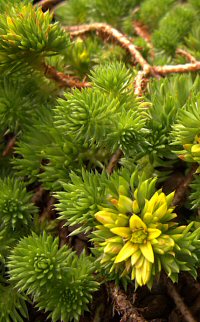 |
Sedum aff. beauverdii HWJ824
Another of our Vietnamese collections has been re-branded Sedum aff. beauverdii HWJ824 somewhat unconvincingly I have to confess, as this relates to a Chinese species from much higher altitudes.We will also have some plants of S. morrisonense BSWJ7078 another yellow flowering prostrate grower,
|
but named after the highest mountain in Taiwan, Mt. Morrison that was (Yushan nowadays).
I must mention Rubus taiwanicola CWJ12400 as again a new collection proved superior in form, hopefully we can propagate from the few plants left after the onslaught. Ardisia japonica BSWJ1032 hails from the island of Chejudõ South Korea, where this small evergreen tightly suckering shrub covers the forest floors bearing small white flowers in clusters followed by bright red fruit.
 |
A. takedae BSWJ11424
Adenophora BSWJ8608 refuses to be categorised, never the less it proved irresistible last year as A. radiatifolia, it has been re-christened as A. verticillata this year. A. takedae BSWJ11424 is a much smaller plant collected on a memorably beautiful day at the top of a Shikoku mountain where we found untold goodies on our ascent.
|
At last Lobelia montana BSWJ8220 has been identified, a peculiar species from the dark forests of Vietnam and beyond.
 |
Impatiens species from China DJHC98415
I wish the same could be said for Impatiens species from China DJHC98415, it is a worthy plant which appears to be well behaved, a female only clone with shell pink flowers over dark green foliage.
|
A wonderful collection gathered at high altitude by our good friend and fellow collector Dan Hinkley on the fabled E'meishan, Sichuan China in 1998.
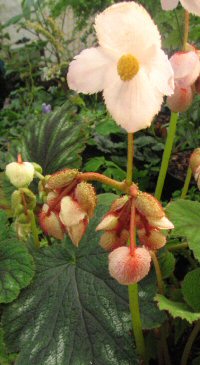 |
Begonia annulata HWJK2424
Begonia annulata HWJK2424 was a collection from our last Nepalese expedition where its patterned leaves could be seen clinging to vertical cliffs on our decent down the Mewa Kola. A very distinct species with large pale pink flowers emerging from red bristly buds in a long succession. B. sikkimensis BSWJ2692 is a fresh identity for the species we collected in Sikkim in 1994, where it grew in the shelter of the forest, it needed to as the diesel in our Jeep froze.
|
 |
Remusatia hookeriana BSWJ2529
Remusatia hookeriana BSWJ2529 was a collection from that same area, a peculiar little aroid which thrusts out long stolons with embryo tubers, which root into any leaf litter it comes into contact with. Yet growing as an epiphyte with small white ageing yellow spathes born after the peltate to heart-shaped leaf dies down.
|
 |
Polygonatum cathcartii BSWJ2429
Not many people realise that many Polygonatum species also grow as epiphytes, such is the case with the very distinct P. cathcartii BSWJ2429 a collection from the upper altitudes of the forests further west in Sikkim, even up to the tree line. A yellow flowering species with opposite leaves held on long arching purple mottled stems,
|
not to be confused with P. oppositifolium an evergreen species from the same area, but from a lower elevation.
Two other species are joining our inventory this year from China,P. prattii is the smaller with scattered leaves on a stem to 30 cm tall and axillary pink-lilac flowers followed by their distinct pink fruit.
 |
Polygonatum roseum
P. roseum is of a similar habit but taller and narrower foliage. P. tonkinensis white/green flowering HWJ861 is another epiphytic species (perfectly adaptable to terrestrial growing) similar in habit to our other collections but on larger plants with of course different coloured flowers
|
at high altitude, alas the over grazing of such areas over the years has restricted the species as well as this pink flowering form to only a few small areas. It has the same habit as the North American M. stellatum, but with far more flowers and of course pink in this rare variety.
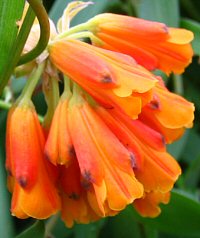 |
Bomarea hirsuta BSWJ10774
Moving down a touch in altitude, Bomarea are valuable herbaceous climbers, which we are learning to site under shrubs in the garden. This avails them just enough frost protection to emerge the following year with
|
strong twining shoots which present a wonderful display of their Alstroemeria-like trumpet flowers by late summer and autumn out of doors, or for most of the year under protection. B. hirsuta BSWJ10774 is a small species collected from the Paramo to the south of Bogota, with a congested cluster of bright orange flowers. B. multiflora BSWJ10681 has larger flowers more of a yellow ageing to orange, although different from what we have grown as B. caldasii for many years, which we will also be offering this season.
Globba hookeri HWJCM471 is a member of the ginger family, which we collected a few bulbils of on our 1995 expedition to Nepal. For us it forms a slender plant to over a meter tall with slender terminal spikes of strange yellow flowers that transform to bulbils. Hedychium coronarium BSWJ3745 may be a more familiar member of the family, this represents a collection from Taiwan where it has naturalised long ago. H. × raffillii was a gift from Dan several years ago, every year it reliably produces a wonderful display of pale orange spidery flowers.
 |
Aristea ecklonii GWJ9469
Aristea ecklonii GWJ9469 from the mountains of Sri Lanka looked very similar to Orthrosanthus another blue flowering monocot that we saw seeding everywhere in Central America. Although I read that A. ecklonii originates from grassland and scrub of South Africa's Eastern Cape to Tanzania.
|
Where as R. cautleyoides BWJ7781 is distinct enough to warrant a cultivar name as it has sizeable flowers born late in the season, see the description at the end.
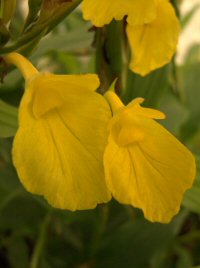 |
Caulokaempferia petelotii BSWJ11818
Caulokaempferia petelotii BSWJ11818 may well have to be cultivated in pots, not because it is tender, but small. We have grown this demure species with outlandish bright yellow flowers for its size ever since we found it growing in the north of Vietnam in
|
a deep gorge high in the cool mountain forests, where it clings to the almost bare mossy cliffs with its tiny fleshy roots. This is a slow growing plant that will always be scarce, please do not expect us to have pots and pots of it.
 |
Heloniopsis koreana BSWJ4173
Heloniopsis koreana BSWJ4173 is a collection of a recently described species with nodding purple to blue flowers that we collected from South Korea.
|
We are also adding another Japanese collection identified as H. orientalis v. flavida BSWJ11400 with white purple stained flowers (thought flavida meant yellow?).
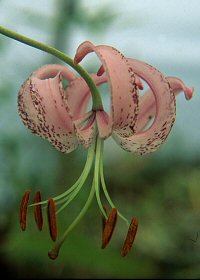 |
Lilium lankongense BWJ7691
We will be offering a few new lilies amongst them is Lilium lankongense BWJ7691 my collection from China with grassy foliage and pale pink turk’s-cap flowers.
|
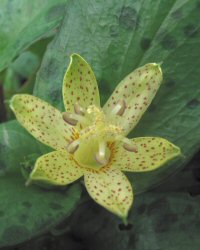 |
Tricyrtis nana BSWJ11399
While Tricyrtis nana BSWJ11399 is a long awaited addition, it was abundant once we tapped into the rich seam of wild populations of this vertically challenged yellow flowering species running through Shikoku.
|
Although we have grown plants labelled as this species from cultivation in Japan these do differ considerably, forming wonderfully dark mottled grey foliage in rosettes that are pressed onto the ground.
 |
Tofieldia aff. coccinea
Tofieldia aff. coccinea is another charming dwarfed plant with small sword-shaped leaves in fans and white-pink flowers. We have seen sizeable populations of this little plant growing on ledges of damp shady cliffs.
|
Already established in cultivation is Iris orientalis, which we were given seed of some years back.
 |
Iris orientalis
The resulting tall plants with large yellow-white flowers have performed so well over the years that customers are demanding that we offer it, who are we do deny them….
|